Free Online Productivity Tools
i2Speak
i2Symbol
i2OCR
iTex2Img
iWeb2Print
iWeb2Shot
i2Type
iPdf2Split
iPdf2Merge
i2Bopomofo
i2Arabic
i2Style
i2Image
i2PDF
iLatex2Rtf
Sci2ools
JCDL
2003
ACM
2003
ACM
Acquisition, Representation, Query and Analysis of Spatial Data: A Demonstration 3D Digital Library
The increasing power of techniques to model complex geometry and extract meaning from 3D information create complex data that must be described, stored, and displayed to be useful to researchers. Responding to the limitations of two-dimensional (2D) data representations perceived by discipline scientists, the Partnership for Research in Spatial Modeling (PRISM) project at Arizona State University (ASU) developed modeling and analytic tools that raise the level of ion and add semantic value to 3D data. The goals are to improve scientific communication, and to assist in generating new knowledge, particularly for natural objects whose asymmetry limit study using 2D representations. The tools simplify analysis of surface and volume using curvature and topology to help researchers understand and interact with 3D data. The tools produced automatically extract information about features and regions of interest to researchers, calculate quantifiable, replicable metric data, and generate metad...
| Added | 05 Jul 2010 |
| Updated | 05 Jul 2010 |
| Type | Conference |
| Year | 2003 |
| Where | JCDL |
| Authors | Jeremy Rowe, Anshuman Razdan, Arleyn Simon |
Comments (0)

